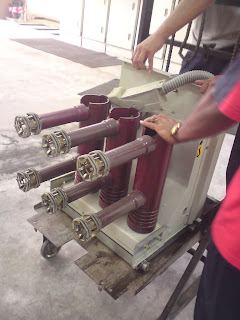Bubbly Bali
Friday, June 3, 2011
new life
Sunday, February 27, 2011
Wednesday, February 23, 2011
........
Monday, February 21, 2011
anuar zain??
alhamdulillah~
Sunday, February 20, 2011
emergency case~
Saturday, February 19, 2011
bismillah~
aku MARAH!!!!!
Tuesday, August 31, 2010
test lagi~
Monday, August 30, 2010
potluck
tidak productive
Thursday, August 26, 2010
yeayyy~
Wednesday, August 25, 2010
muaahahaha~!
Monday, August 23, 2010
zombie mode
Saturday, August 21, 2010
chak2~!
Saturday, July 17, 2010
weehuuu~!
Monday, May 3, 2010
25/4/2010
all the "gangs" gathered~
Thursday, April 29, 2010
21/4/2010
I read the Distribution Planning Guideline Handbook. One of the topic is about MV Network Configuration. The MV Distribution Network in TNB operates at voltages of 6.6, 11, 22 and 33 kV
and interlinks the transmission system and the LV distribution system.
TYPE OF NETWORK CONFIGURATION
There are three basic network configurations that are commonly in use are;
(a) the radial circuit,
(b) the mesh circuit, and
(c) the loop circuit.

Performance of some common network configuration with respect to several different sets of characteristics as listed below:-
• Construction characteristic
• Operation characteristic
• Maintenance characteristic
The salient features of the various network configurations under consideration are
as follows:-
• Radial circuit
• Mesh circuit
• Loop circuit from same ppu/pmu
• Loop circuit from different ppu/pmu
• Loop via switching station (n+1 grouping)
• Petal configuration
• Bulk supply interconnector configuration
Today, my focus suggested by my supervisor is the Petal Configuration.
• The “petal configuration” is one method to improve reliability and security of supply.
• The “petal configuration is developed by interconnecting a loop circuit form one PPU/PMU to a loop circuit from another PPU/PMU via a switching station or the bus-section of a normal substation.
• Individual cable loops are operated in a “close loop” arrangement with 50% loading level.
• All circuit breaker substations are installed with unit protection for cable and SCADA supervisory system for remote switching
• An off-point is maintained at the switching station or bus-section.
The main advantages of this network configuration are:-
• No supply interruption due to single cable fault outage
• Full feedback even if one of the PPU/PMU outage
• SCADA system to detect cable fault and perform remote switching
The disadvantage of this network configuration is:-
• the inherent high cost of installing SCADA system and circuit breaker substations.

20/4/2010
Yuhuu~
I studied about Distribution Network Master Plan (DNMP).It is part of a distribution planning cycle and process to assess the future (planning horizon: 1-3 years for 11kV and 1-5 years for 33kV) distribution system conditions and identify system development options for compliance to the distribution system performance objectives or defined performance targets.
The key objectives of this annual planning exercise for distribution system planners are:
1) To provide fact-based assessment of network performance (existing and future years within planning horizon).
2) To review system performance objectives/targets.
3) To review TNB Distribution planning and development strategies, policies if necessary.
4) To develop & test network solutions in meeting system performance objectives.
5) To identify and select best network development options.
6) To identify medium-term system development and reinforcement CAPEX for a supply zone and state.
Overall, the system planning process and preparation of a master plan undertaken in
DNMP would provide a comprehensive analysis and documentation of the current and future system performance status as well as the investment required to meet the targeted system performance objectives.
The DNMP will encompass the following tasks and analyses for a supply zone:
1) Network modeling of all subsystems (33kV)
2) Load scaling based on disaggregated demand forecast.
3) Load flow, security and contingency analyses.
4) Short circuit analysis.
5) Determination of target networks founded on best network solutions.
6) Recommendation of network expansion and reinforcement projects.
7) Preparation of summary report.
DNMP Methodology
The methodology or approach adopted for 33kV DNMP is as outlined in Appendix 1. A brief overview of the methodology and tasks undertaken in this planning exercise is shown in the flow-chart below.
that's all for the day~
bye













































